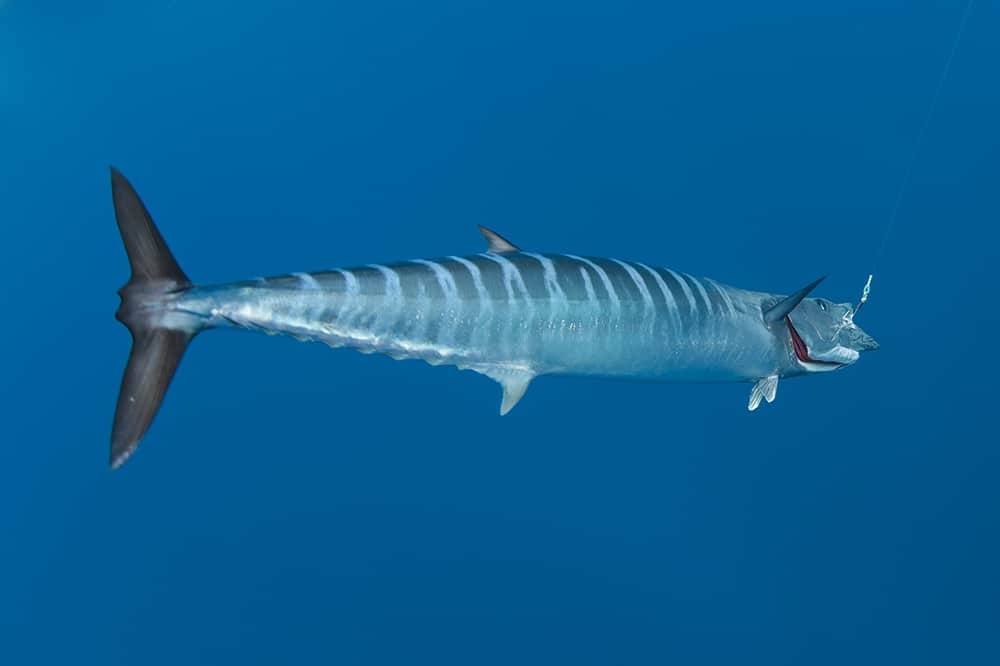
Two universal truths about wahoo make the pelagic species so popular: raw speed and pack mentality. Those two characteristics also make ‘hoos a prime candidate for high-speed trolling. Capable of speeds up to 60 mph, wahoo have little trouble attacking lures trolled at 15 knots. Additionally, fast trolling speeds allow anglers to cover large swaths of water.
But what if you don’t want to pay the gas bill to speed-troll all day, or you don’t have the proper gear to handle it? High-speed trolling is just one effective way to catch wahoo, but it’s not the only way. I spoke with five accomplished captains, probing them to reveal their own proven tactics to catch wahoo.
Use Live Bait to Catch Wahoo
When Capt. James Robinson, of Wound Up Charters, targets wahoo along the Bermuda coast, he favors trolling live baits such as frigate mackerel and robins (scad). Large wahoo are attracted to bait schools that hang on the up-current sides of the steep island and offshore banks.
“This is a light-drag fishery, just 5 to 10 pounds, so we use Shimano Tiagra 16s spooled with 50-pound braid,” says Robinson. “We add a top shot of 40-pound Sufix, and then 23 feet of 80-pound wind-on leader. Our terminal gear consists of two 6/0 or 7/0 hooks (hooked into the bait) rigged with No. 8 or 10 wire.”
Robinson utilizes a three-rod spread, trolling at just 3 to 4 knots. He fishes two lines off the outriggers and one line off the downrigger. It’s a simple, efficient system that works: Robinson’s current record is 51 ’hoos in a day!
“Most days here, the fish caught live-baiting are considerably larger than those caught on artificials or ballyhoo,” he says. Besides, wahoo aren’t the only fish to bite; blue marlin and yellowfin tuna also attack the live baits, a prime reason why long leaders are necessary.
Troll for Wahoo Using a Traditional Eight-Bait Spread
Late summer to October finds Capt. Dan Rooks, of Tuna Duck Sportfishing based in Hatteras, North Carolina, trolling the shallow side of the continental shelf. Rooks trolls his eight-bait spread of skirted ballyhoo at 5½ to 8 knots, keying in on bait schools hanging in 90 to 300 feet of water.
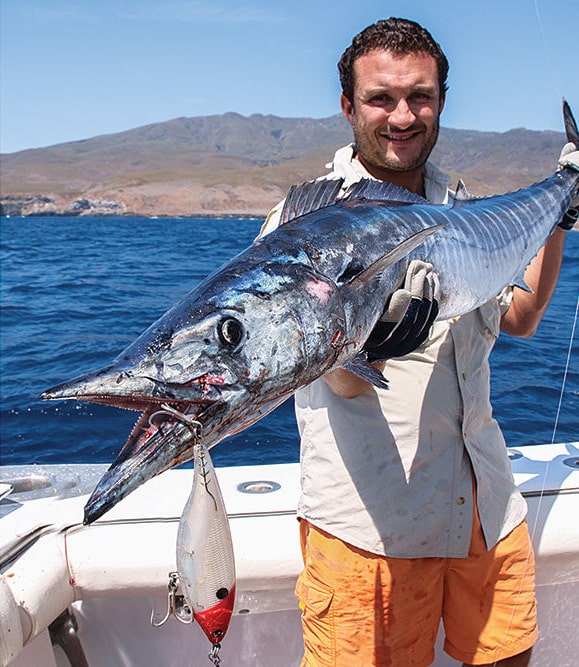
“All the ballyhoo get a skirt, such as a Sea Witch or Ilander,” says Rooks. “Two baits are flat, off the transom, plus two baits are pulled from each outrigger. The shorts are set three wave lengths back; the longs are six wave lengths. The last two lines are shotgun rigs off the tower.”
For tackle, it’s as simple as 300 yards of braid on a 50-pound-class outfit, with a top shot of monofilament. A wind-on leader connects to the ballyhoo rig with a SPRO snap swivel (which is safe to wind onto the reel).
“The wahoo can school up, leading to multiple hookups at once,” says Rooks. “Most of the bites are on top. When the wahoo fishing is hot, so is the sailfishing — I’ve caught sails and wahoo simultaneously.”
Troll Lipped Plugs
Capt. Mike Weinhofer, of Compass Rose Charters based in Key West, Florida, trolls six to eight lipped plugs at the End of the Bar, an old coral-reef tract that drops off toward the continental shelf near Key West. Using lures such as the Rapala Magnum (15s, 20s and 30s) and Williamson Speed Pro, Weinhofer expertly picks off ‘hoos stacked in 40 to 250 feet of water.
“You can actually tune a plug by bending its metal lip to turn a certain direction when trolling,” says Weinhofer. “I’ll set up a V-pattern, with a mix of plastic- and metal-lipped baits.”
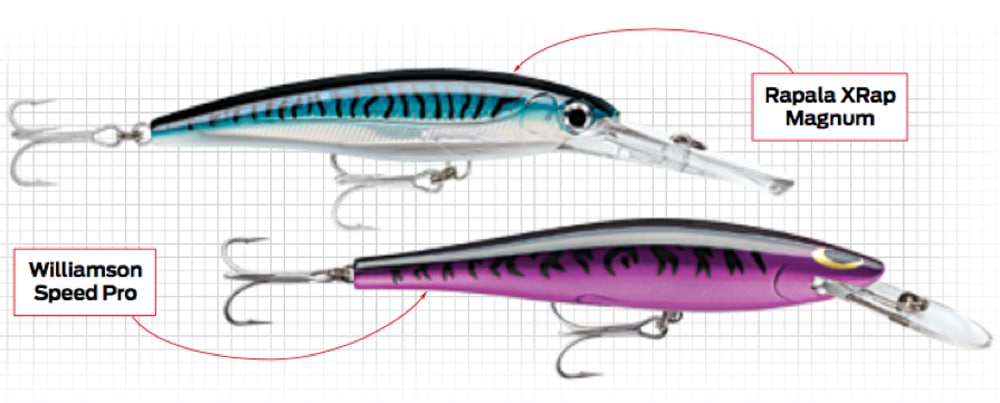
Weinhofer uses 20-pound-class tackle paired to rods with a fast-taper tip, mostly to counter the violent headshakes of wahoo. When the spread is dialed in, expect plenty of action at just 6 to 7 knots.
“Stay away from wire leader to increase wahoo hookups, and never tie a leader directly to the lure,” he says. “Instead, use a snap swivel tied to 50-pound mono because it allows you to troll faster, if necessary.”
And don’t get frustrated if a plug tracks wrong after a fish is caught. Make sure the lure eyes that hold the trebles are not bent. If so, straighten with pliers so the lure tracks true once more.
Jig for Wahoo Near an Oil Rig
Capt. Hunter Caballero, of Paradise Outfitters based in Venice, Louisiana, prefers jigging and chumming to trolling when he’s fishing around the many rigs and platforms that pepper the edge of the continental shelf in the Gulf of Mexico.
“Ideal locations can start anywhere past 200 feet of water, as close as 7 miles out,” Caballero says. “Wahoo will ball up baits near the rigs, especially on the up-current side.”
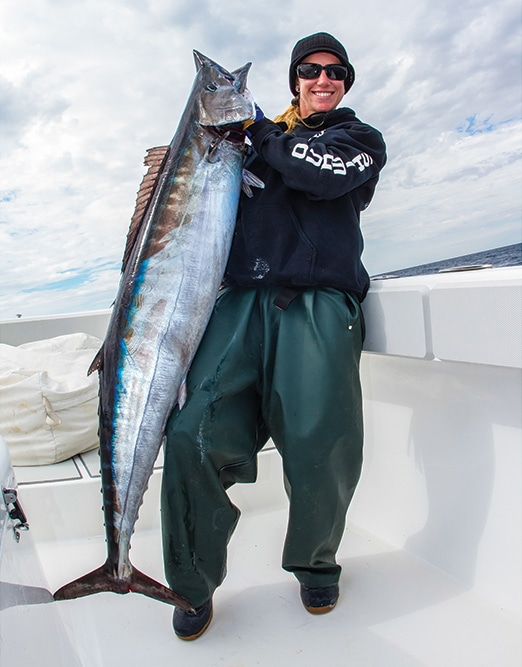
Caballero uses his electronics to mark tuna in the water column; hefty tunas show as bigger echoes, while the wahoo are smaller blips. “Wahoo will come up to the chum at the surface just like tuna,” he says. “They’ll even hit chunk baits. We jig around oil rigs for wahoo, yellowfins and blackfins all at the same time.”
For gear, the Penn VSX 16 is fast enough to handle speedy metal jigs, he says. “I tie 80-pound braid main line to a swivel, then attach 1 foot of No. 9 wire to a metal jig like the Shimano Butterfly. You must use wire assist hooks with the jig, or the wahoo will cut your hooks off.” Average ’hoos weigh 50 pounds, he says, with 100-pounders available in the winter months.
Cast a Jig to Wahoo
“Always have a ‘jig stick’ ready when trolling for wahoo,” says Larry Brown, a veteran long-range fisherman and charter master in Southern California. “When a trolling rod goes off, cast out your jig quickly.” Wahoo often gang up in packs, something anglers capitalize on while fishing off the coast of Baja Mexico.
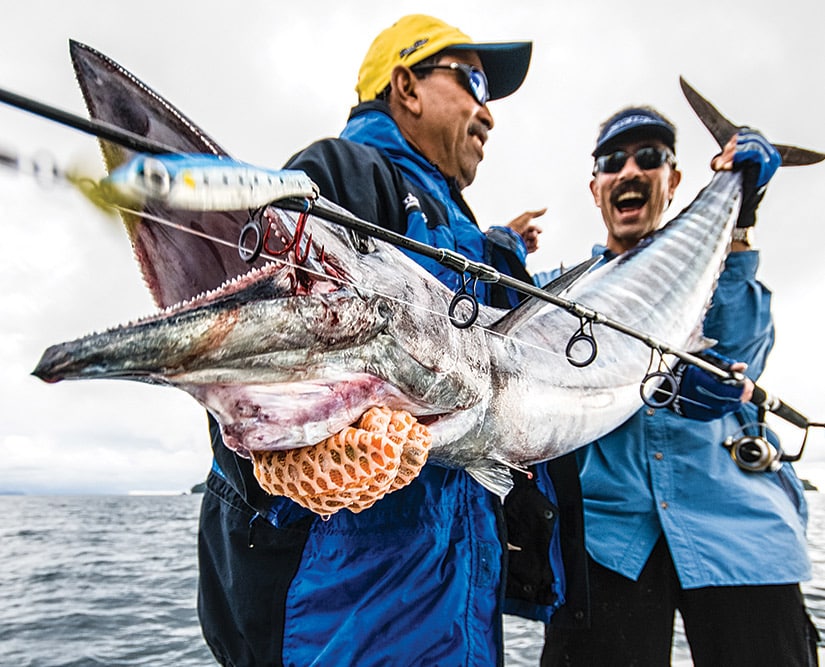
The jig Brown’s talking about is short, thin, and of high-density zinc or stainless steel — produced from popular companies such as Raider, Salas and HighTideSportfishing.com — that anglers crank at high speeds. The jig’s weight, plus a stiff-action jigging rod, allows anglers to cast for distance. A second popular casting lure is the wahoo bomb, featuring a heavy, bullet-shaped head with flashy skirt and blade. Numerous companies, and even anglers themselves, produce and create their own variations of bombs.
“Wahoo bite so hard on the lures that sometimes they’ll grab tight without getting hooked,” he says. “Casting smaller, low-profile jigs gives wahoo less to grab onto and better chances to get hooked.”
Brown recommends a high-speed fishing reel, capable of at least 40 inches per crank, paired with a 7½- to 8-foot rod. “I never pump the rod — that creates slack,” says Brown. “I use a stupid-tight drag, 60-pound Spectra, and sharp hooks to set the hook, and I always aim the rod at the fish when reeling in the wahoo.”








